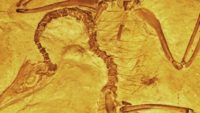Evolution, it is claimed, removes the need for a designing intelligence of life on Earth, but this amounts to the logically absurd proposition of ‘Unintelligent Design’. …read more Source: creation.com
What is ‘paradigm blindness’ and how can creationists counter it? …read more Source: creation.com
By Ken Ham As we’ve reported numerous times on our site, scientists have observed lizards evolving into lizards, salmon evolving into salmon, moths into moths, mice into mice, bedbugs into bedbugs; and more lizards into lizards! I must admit, the evidence that organisms evolve into organisms like themselves is pretty overwhelming! Of course, I say that tongue-in-cheek, but examples of adaptation, speciation, and natural selection are used over and over again as evidence for molecules-to-man evolution—but they’re not! What they really show are examples of what God’s Word teaches—everything reproduces according to their kinds. Lizards produce lizards, salmon …read more [More]
Is there enough time for permafrost to form in the biblical timeframe? …read more Source: creation.com
By Dr. David Menton According to many evolutionists today, dinosaurs are really not extinct but rather are feeding at our bird feeders even as we speak. But what does the Bible tell us about the origin of birds, and just how good is the scientific evidence that some dinosaurs evolved into birds? …read more Source: AIG Daily
Dr. Christopher Gardner, director of nutrition studies at the Stanford Prevention Research Center, and his colleagues conducted a study on 609 overweight and obese adults living in San Francisco’s Bay Area. Nutritionists coached the adults not to bother with counting calories. They should eat until they felt full, but eat plenty of vegetables and whole foods. The study results held a few surprises. First, the study pa… More… …read more Source: icr.org
Despite saying he’s irritated by the creation debate, one author goes to great lengths to add to the discussion. …read more Source: creation.com
The theory of plate tectonics recently turned fifty. Contrary to the claims of its critics, the theory of plate tectonics is derived from empirical data collected over many decades by geologists and geophysicists.1 In the early 20th century, Alfred Wegener studied the shapes of the continents, matched fossils and mountain ranges across vast oceans, and suggested that the continents had drifted apart. At the time… More… …read more Source: icr.org
By Troy Lacey Researchers found that sexual size dimorphism may be limiting South American lizards’ speciation. Males and females of the same species may be filling ecological niches usually filled by separate species. Is this an example of evolution in action or a designed adaptive feature input into the lizard kind’s genome? …read more Source: AIG Daily
By Dr. Nathaniel T. Jeanson The progress of science over the last 150 years has not only rebutted Darwin’s central arguments for evolution; it has also replaced them with an entirely different scientific explanation for the origin of species. Recent research on Darwin’s finches has confirmed this bold pronouncement. …read more Source: AIG Daily
Highly concentrated fossil tracks found near NASA Goddard Space Center support Noah’s Flood …read more Source: creation.com
It was an obvious hoax that should have been easy to sniff out, so why were so many taken in? …read more Source: creation.com
Sneak peek of latest Creation magazine. Shellfish has tiny eyes structured like some advanced reflecting telescopes, but make two images. …read more Source: creation.com
By Dr. Alan Gillen Since bacteria can add information, could this process be used as evidence for evolution? The answer is no. Evolutionists may argue that this is acquiring information, but the acquisition of small DNA segments is still leading to disease. …read more Source: AIG Daily
The planaria, a type of flatworm, has an amazing capacity to regenerate a new body from just fragments of tissue. Its genome has just been sequenced. The surprising result is a completely unexpected evolutionary conundrum. Planarians (S. mediterranea) are a type of freshwater flatworm commonly found between about 3 to 15 mm in length.1 Their size can actually self-adjust within a 50-fold range depending on the… More… …read more Source: icr.org
The petrified tree-trunks found in the beautiful national park at Yellowstone have been used for years to ‘prove’ that the Earth cannot be young as the Bible indicates. But the evidence shows otherwise. …read more Source: creation.com
Big Bang scientists are wrestling with “serious” contradictory estimates for the size of the Hubble constant—one of the most important numbers in cosmology.1,2 The Hubble constant, indicated by the symbol H0, is important because it’s thought to give the current expansion rate of the universe. It indicates the speed at which galaxies are apparently receding from one another. This apparent … More… …read more Source: icr.org
By Ken Ham A recent article from Live Science proclaimed, “Oldest Fossil of ‘Missing Link’ Dinosaur Discovered in Germany.” Now, the actual find was not quite that sensational—no “missing link” involved. Actually, there wasn’t even a dinosaur involved! What they found was another fossilized Archaeopteryx specimen—a crow-sized bird with teeth and claws on its wings, as many now-extinct birds had (though penguins still have teeth and hoatzins have claws as juveniles). They found this fossil lower in the rocks than other specimens have been found. Because it’s found in supposedly lower rocks (based on the “index fossil,” in this case [More]
A recent article by a team of paleontologists, led by Hesham Sallam, of Mansoura University, Egypt, claims to have found the Holy Grail of dinosaurs in the middle of Egypt.1 The Genesis Flood model easily explains this unique discovery. The Genesis Flood model easily explains this unique discovery. More… …read more Source: icr.org
By Jeanette Littleton The $3.26 billion Cassini-Huygens mission, launched in 1997, was a resounding success. It vastly improved our understanding of Saturn. The space probe Cassini’s most amazing discovery didn’t make the headlines: the clear testimony to Saturn’s young age and the fact that it had a Creator. …read more Source: AIG Daily
By Ken Ham For most insects, getting eaten is the end—but not for the remarkable bombardier beetle. These little beetles are often discussed in creation literature because of their incredible design features, including the ability to shoot a boiling, noxious gas so they can escape predators. But, according to new research, the bombardier beetle has another trick. Researchers in Japan fed bombardier beetles to toads to see what would happen. Well, nearly half of the toads puked up the beetles anywhere from 12 to 107 minutes after ingesting them. The hardy little beetles scurried off, apparently unharmed. It turns out [More]
By Melissa Webb The latest craze is to learn what DNA tests reveal about family heritage. When an adoptive Christian family decided to look beneath the surface, however, they discovered a more amazing truth, providing powerful evidence that we are all one race, or “one blood,” just as the Bible teaches. …read more Source: AIG Daily
Evolution relies on deep time which in turn relies on naturalism but science tells us the earth is young and so evolution is false. …read more Source: creation.com
The salinity of the oceans is a strong evidence that they, and the Earth itself, are far younger than the billions of years required for evolution, and is consistent with the biblical age of about 6,000 years. …read more Source: creation.com
By Ken Ham When you think of fossils, you probably picture dinosaurs, trilobites, or other exotic and extinct creatures. But did you know there are many examples of much more familiar creatures throughout the fossil record? A Order your copy of Living Fossils today! And, contrary to what the article states, these ducks are certainly not the only example of modern birds buried with dinosaurs. We find fossilized parrots, albatrosses, loons, owls, flamingos, penguins, sandpipers, and more buried in the same layers as dinosaurs. And one evolutionary researcher claimed that such evidence supports the idea that “most or all of [More]
Because cells have the ability to adapt to certain stresses, such as a lack of food, they must have been functioning that way from the start. …read more Source: creation.com
By Ken Ham There seems to be no end to the variety of amazing creatures being discovered preserved in amber in Myanmar. We’ve written on a supposed “feathered dinosaur” (it was just a bird), beautiful flowers, and a tiny chameleon that have all been found stuck in the sticky tree resin that later hardened to preserve them. And now researchers have found a beautifully preserved spider with a tail longer than its body. Apparently the new species “looks just like a spider, with common body parts including fangs and four [pairs of] legs that are specifically used for walking.” The [More]

















































